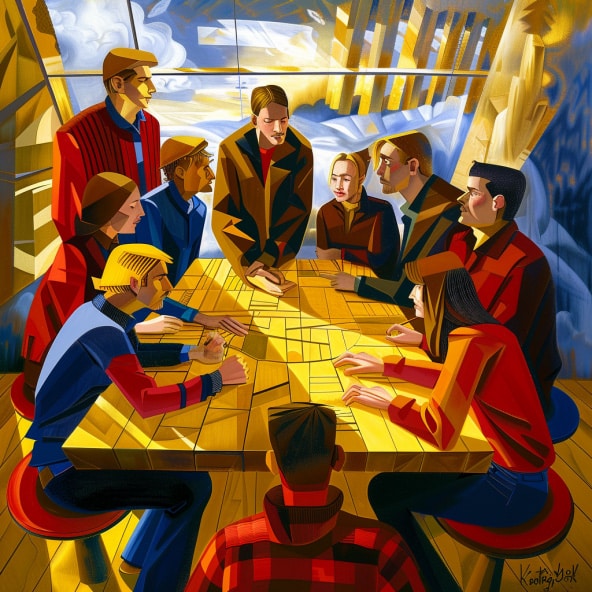“Don’t save the canary. Fix the coal mine.” – Seth Godin
In our busy, frantic workplace worlds, where every day feels like a new episode of a workplace sitcom, the concept of vulnerability-based trust might seem mushy and irrelevant, if not annoying. I get it. But annoying is OK with me. It means maybe you’re paying attention.
The kind of trust we constantly talk about over here is the unsung hero of the corporate success narrative. This isn’t about the weepy, and let’s face it, short-lived and sometimes totally fake “let’s-all-hold-hands” kind of trust. It’s about the courage to be real, the strength to be open, and the power that comes when a team embraces these values.
So it’s important to look for the “canaries in your trust mine” and when you find them, check for signs of life.
The Journey to Trust
 Vulnerability-based trust is like the superpower of high-performing teams. It’s about creating a space where it’s okay to say, “Hey, I messed up,” or “I need help with this.” It’s where team members can drop their professional masks and be genuine without the fear of being judged or ridiculed. Our canaries are not just living but hopping around in joyous celebration when we have this kind of trust. So how do we know when trust is lacking, and the oxygen in your trust mine is too low?
Vulnerability-based trust is like the superpower of high-performing teams. It’s about creating a space where it’s okay to say, “Hey, I messed up,” or “I need help with this.” It’s where team members can drop their professional masks and be genuine without the fear of being judged or ridiculed. Our canaries are not just living but hopping around in joyous celebration when we have this kind of trust. So how do we know when trust is lacking, and the oxygen in your trust mine is too low?
Elevate your leadership style.
Learn the power of vulnerability in our Executive Coaching Program.
Recognizing Your Canary’s Trust Deprivation Sickness
Imagine you’re at a team meeting. Everyone’s nodding, but it’s more of a reflex than a sign of agreement. This is where the story of trust, or the lack thereof, begins.
The Superficial Small Talk: You’ve seen it – conversations that never go beyond the weekend weather or the latest office gossip. Then everyone reports what they’re doing and when they ask for questions, the canary sleeps and the crickets take over. It’s like everyone prefers a smooth ride in the trust mine even if they can’t breathe down there. Here’s a few surefire signs that things are going the wrong way:
- The Harmony Hoax: Ever noticed how some teams seem to agree on everything? It’s like they’re reading from the same script. But beneath this facade of harmony, there’s a lack of genuine debate, and that’s where creativity and innovation go to hibernate. So, we all know it’s not that people don’t talk to anyone. They talk all the time. But not to each other. Not to the people who need to hear. And an underground reality check, like a subterranean River Negative flowing underneath your trust mine. Its current flows strong and spreads ill will and negativity just below the surface. People are telling you, but they ask you not to repeat what you now know is killing your organization and healthy teamwork.
- Mistake? What Mistake? Then there’s the classic cover-up. Someone makes a blunder, but instead of owning up, they shove it under the rug. It’s the workplace version of “the dog ate my homework”. Or when someone makes a mistake, maybe everyone smiles in the meeting, but afterward, they all go visit the River Negative in private little gatherings.
- Disengagement Drama: Picture this: half the team looks like they’re mentally planning their next vacation during meetings. That’s not just boredom; it’s a sign they don’t feel safe or valued enough to contribute. They are hungover from drinking too much from the River Negative and the only relief from their pain is to pretend not to be there
Breathing Life into Your Trust Mine
 So, how do you open those mine shafts to the light and oxygen necessary for sustaining your team’s life and productivity? It starts with the person in the captain’s chair – you, the manager.
So, how do you open those mine shafts to the light and oxygen necessary for sustaining your team’s life and productivity? It starts with the person in the captain’s chair – you, the manager.
- Be the Role Model: If you want your team to open up, you’ve got to lead the way. Share your own challenges and how you overcame them (or didn’t). It’s like telling your team, “It’s okay not to be perfect.”
- Safe Zone Setup: Create an environment where mistakes are not just tolerated but seen as stepping stones to learning. It’s about shifting from a “gotcha” mindset to a “got your back” culture. Never ever lose the opportunity to tell the story of how you messed up and turned it into learning. Eventually, your team will get used to it and join in.
- The Art of Genuine Dialogue: Encourage conversations that go beyond the daily grind. Ask your team how they’re really doing and listen – really listen.
- Celebrating Vulnerability: When someone shows courage by being vulnerable, acknowledge it. It sends a message that says, “We value realness here.” That’s what leadership looks like.
- Setting the Stage for Trust: Getting started might feel like reinventing the wheel, but it’s more about small, consistent steps. A great way to start is the recommendation of our favorite workplace guru, Patrick Lencioni, who recommends a Personal Histories exercise in which each team member shares some safe and benign information about their childhoods or personal lives, such as how many siblings they had, where they grew up, who their favorite teacher was and why, what their favorite flavor of ice cream is. This information is not inherently useful or actionable on the surface. But it begins the process of sharing your humanity with others without sharing your “inner child.” And this is the foundation for talking about your biggest mistakes or what keeps you up at night, which is the next stage of exercising those vulnerability muscles.
- Introspection Insight: Take a moment to reflect on your own approach to vulnerability. Are you setting the right example? Do you share your own mistakes? Do you ask for help? Admit that you don’t know the answer? Share stories about when you really messed up and how you overcame it?
- Team Bonding, Redefined: Introduce activities or discussions that allow team members to share more about themselves – their interests, challenges, and aspirations. And beyond the Personal Histories exercise mentioned above, make this a regular habit. Take time in meetings to connect and not just “do.”
- Consistent Check-Ins: Make it a habit to have regular one-on-one conversations with your team members. Create a space where they can share freely without fear of judgment.
A Reflective Pause for Managers
 As you embark on this journey, consider these questions:
As you embark on this journey, consider these questions:
- How often do I share my professional challenges with my team?
- What steps can I take to reinforce a culture where it’s safe to be vulnerable?
- How do I respond when a team member takes a risk, and it doesn’t pay off?
- What actions can I implement today to start nurturing a trusting team environment?
In the end, building and maintaining your team’s trust mine is about creating a space where everyone feels comfortable being their authentic selves. It’s not just about enhancing performance; it’s about forging stronger, more resilient teams that can weather any storm together. And that, in the fast-paced narrative of the corporate world, is a mine worth pursuing.
“You know it’s time to start using mouthwash when your dentist leaves the room and sends in a canary.” – Joan Rivers
Seeking to improve your workplace culture or team dynamics?
Contact PointerWise for professional insights and solutions.






